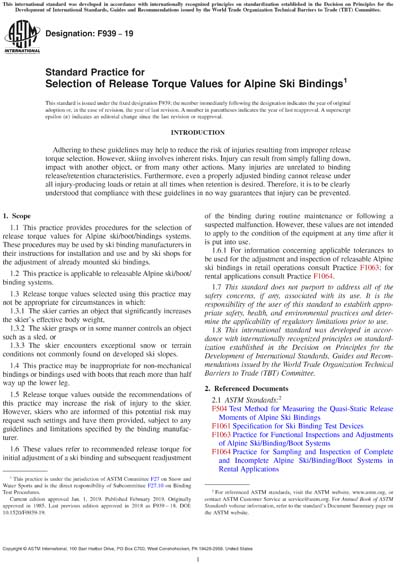Most recent
ASTM F939-19
Standard Practice for Selection of Release Torque Values for Alpine Ski Bindings
1.1 This practice provides procedures for the selection of release torque values for Alpine ski/boot/bindings systems. These procedures may be used by ski binding manufacturers in their instructions for installation and use and by ski shops for the adjustment of already mounted ski bindings.
1.2 This practice is applicable to releasable Alpine ski/boot/binding systems.
1.3 Release torque values selected using this practice may not be appropriate for circumstances in which:
1.3.1 The skier carries an object that significantly increases the skier's effective body weight,
1.3.2 The skier grasps or in some manner controls an object such as a sled, or
1.3.3 The skier encounters exceptional snow or terrain conditions not commonly found on developed ski slopes.
1.4 This practice may be inappropriate for non-mechanical bindings or bindings used with boots that reach more than half way up the lower leg.
1.5 Release torque values outside the recommendations of this practice may increase the risk of injury to the skier. However, skiers who are informed of this potential risk may request such settings and have them provided, subject to any guidelines and limitations specified by the binding manufacturer.
1.6 These values refer to recommended release torque for initial adjustment of a ski binding and subsequent readjustment of the binding during routine maintenance or following a suspected malfunction. However, these values are not intended to apply to the condition of the equipment at any time after it is put into use.
1.6.1 For information concerning applicable tolerances to be used for the adjustment and inspection of releasable Alpine ski bindings in retail operations consult Practice F1063; for rental applications consult Practice F1064.
1.7 This standard does not purport to address all of the safety concerns, if any, associated with its use. It is the responsibility of the user of this standard to establish appropriate safety, health, and environmental practices and determine the applicability of regulatory limitations prior to use.
1.8 This international standard was developed in accordance with internationally recognized principles on standardization established in the Decision on Principles for the Development of International Standards, Guides and Recommendations issued by the World Trade Organization Technical Barriers to Trade (TBT) Committee.
Content Provider
ASTM International [astm]






